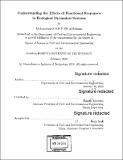Understanding the effects of functional responses in ecological dynamical systems
Author(s)
AlAdwani, Mohammad S. Kh. F. Sh.
Download1102679160-MIT.pdf (2.689Mb)
Other Contributors
Massachusetts Institute of Technology. Department of Civil and Environmental Engineering.
Advisor
Serguei Saavedra.
Terms of use
Metadata
Show full item recordAbstract
The main purpose of incorporating functional responses into ecological models has been to add more realism and to help us to mechanistically explain the dynamics of species abundances in nature. Yet, their effects have not been widely understood, especially in multispecies systems. That is, it remains unclear whether the perceived benefits of adding functional responses are simply mathematical artefacts or not. For example, while functional responses have been useful to model the dynamics of 2-species systems, still some functional responses have been criticized for producing unrealistic results. Moreover, it has been unclear the extent to which adding functional responses in multispecies systems can allow the dynamics to reach any type of behavior, contrary to the limits that nature may impose. Thus, it is necessary to fully understand the effect of functional responses on ecological models as it is directly linked to their explanatory power of ecological dynamics. In this Masters thesis, we examine the effect of functional responses in 2-species and multi-species models (or systems). In particular, we examine the number of interior fixed points that are added into dynamical models by introducing functional responses. This number is linked to the capacity of a model to fit data and to the model's sensitivity to perturbation in its parameters. Note that classic ecological models without functional responses have only one interior fixed point regardless of the dimension of the system. We introduce, for the first time, a methodology to count the number of interior fixed points present in a dynamical system with functional responses. In particular, for 2-species models, we uncouple the 2-variable isocline equations (after some manipulations) into two separate single variable equations and examine them. For multispecies models, we compute the mixed volume (number of interior fixed points) of the system's isocline equations (after some manipulation). We show that incorporating functional responses into 2-species models feeds the system with one or two extra interior fixed points. Importantly, this number increases exponentially in multispecies systems. Hence, we conclude that the explanatory power of multispecies models with functional responses is drastically reduced if model parameters are not ecologically restricted. We believe this work sheds new lights on the applicability of functional responses and opens a new dialogue of what constitutes a realistic model.
Description
Thesis: S.M., Massachusetts Institute of Technology, Department of Civil and Environmental Engineering, 2019 Cataloged from PDF version of thesis. Includes bibliographical references (pages 45-46).
Date issued
2019Department
Massachusetts Institute of Technology. Department of Civil and Environmental EngineeringPublisher
Massachusetts Institute of Technology
Keywords
Civil and Environmental Engineering.